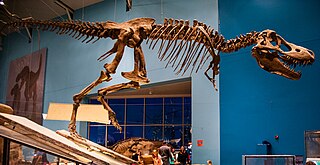
Tarbosaurus is a genus of tyrannosaurine theropod dinosaur that lived in Asia about 70 million years ago, during the Maastrichtian age at the end of the Late Cretaceous period, considered to contain a single known species: Tarbosaurus bataar. Fossils have been recovered from the Nemegt Formation of Mongolia, with more fragmentary remains found further afield in the Subashi Formation of China.

Therizinosaurus is a genus of very large therizinosaurid that lived in Asia during the Late Cretaceous period in what is now the Nemegt Formation around 70 million years ago. It contains a single species, Therizinosaurus cheloniformis. The first remains of Therizinosaurus were found in 1948 by a Mongolian field expedition at the Gobi Desert and later described by Evgeny Maleev in 1954. The genus is only known from a few bones, including gigantic manual unguals, from which it gets its name, and additional findings comprising fore and hindlimb elements that were discovered from the 1960s through the 1980s.

Anserimimus is a genus of ornithomimid theropod dinosaur, from the Late Cretaceous Period of what is now Mongolia. It was a lanky, fast-running animal, possibly an omnivore. From what fossils are known, it probably closely resembled other ornithomimids, except for its more powerful forelimbs.

Deinocheirus is a genus of large ornithomimosaur that lived during the Late Cretaceous around 70 million years ago. In 1965, a pair of large arms, shoulder girdles, and a few other bones of a new dinosaur were first discovered in the Nemegt Formation of Mongolia. In 1970, this specimen became the holotype of the only species within the genus, Deinocheirus mirificus; the genus name is Greek for "horrible hand". No further remains were discovered for almost fifty years, and its nature remained a mystery. Two more complete specimens were described in 2014, which shed light on many aspects of the animal. Parts of these new specimens had been looted from Mongolia some years before, but were repatriated in 2014.

Adasaurus is a genus of dromaeosaurid dinosaur that lived in Asia during the Late Cretaceous period about 70 million years ago. The genus is known from two partial specimens found in the Nemegt Formation of Mongolia that were partially described in 1983 by the paleontologist Rinchen Barsbold.
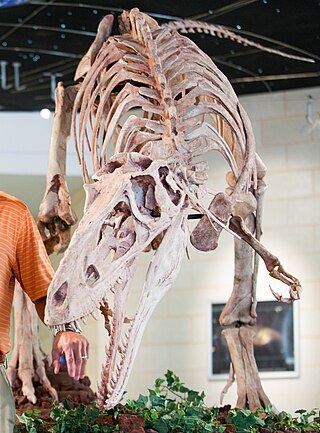
Alioramus is a genus of tyrannosaurid theropod dinosaurs from the Late Cretaceous period of Asia. It currently contains two species. The type species, A. remotus is known from a partial skull and three foot bones recovered from the Mongolian Nemegt Formation, which was deposited in a humid floodplain about 70 million years ago. These remains were named and described by Soviet paleontologist Sergei Kurzanov in 1976. A second species, A. altai, known from a much more complete skeleton also from the Nemegt Formation, was named and described by Stephen L. Brusatte and colleagues in 2009. Its relationships to other tyrannosaurid genera were at first unclear, with some evidence supporting a hypothesis that Alioramus was closely related to the contemporary species Tarbosaurus bataar. However, the discovery of Qianzhousaurus indicates that it belongs to a distinct branch of tyrannosaurs, namely the tribe Alioramini.

Bagaceratops is a genus of small protoceratopsid dinosaurs that lived in Asia during the Late Cretaceous, around 72 to 71 million years ago. Bagaceratops remains have been reported from the Barun Goyot Formation and Bayan Mandahu Formation. One specimen may argue the possible presence of Bagaceratops in the Djadochta Formation.
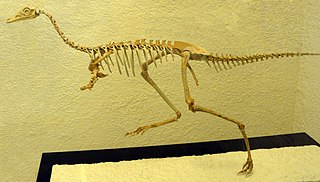
Mononykus is a genus of alvarezsaurid dinosaur that lived during the Late Cretaceous in what is now Asia on the Nemegt Formation, about 70 million years ago.
Kuru is a genus of dromaeosaurid theropod from the Late Cretaceous Barun Goyot Formation of Mongolia. The genus contains only a single species, the type species Kuru kulla, which is known from a fragmentary skeleton including a partial skull.

Tarchia is a genus of herbivorous ankylosaurid dinosaur from the late Cretaceous of Mongolia.
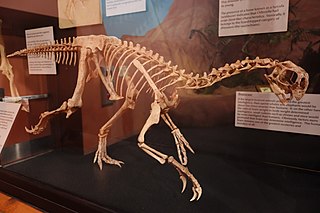
Heyuannia is a genus of oviraptorid dinosaur that lived in Asia during the Late Cretaceous epoch, in what is now China and Mongolia. It was the first oviraptorid found in China; most others were found in neighbouring Mongolia. Two species are known: H. huangi, named by Lü Junchang in 2002 from the Dalangshan Formation; and H. yanshini, originally named as a separate genus Ingenia from the Barun Goyot Formation by Rinchen Barsbold in 1981, and later renamed to Ajancingenia in 2013 due to the preoccupation of Ingenia. The latter name was eventually discarded due to various ethical issues surrounding the author.

Nemegtomaia is a genus of oviraptorid dinosaur from what is now Mongolia that lived in the Late Cretaceous Period, about 70 million years ago. The first specimen was found in 1996, and became the basis of the new genus and species N. barsboldi in 2004. The original genus name was Nemegtia, but this was changed to Nemegtomaia in 2005, as the former name was preoccupied. The first part of the generic name refers to the Nemegt Basin, where the animal was found, and the second part means "good mother", in reference to the fact that oviraptorids are known to have brooded their eggs. The specific name honours the palaeontologist Rinchen Barsbold. Two more specimens were found in 2007, one of which was found on top of a nest with eggs, but the dinosaur had received its genus name before it was found associated with eggs.

Nanshiungosaurus is a genus of therizinosaurid that lived in what is now Asia during the Late Cretaceous of South China. The type species, Nanshiungosaurus brevispinus, was first discovered in 1974 and described in 1979 by Dong Zhiming. It is represented by a single specimen preserving most of the cervical and dorsal vertebrae with the pelvis. A supposed and unlikely second species, "Nanshiungosaurus" bohlini, was found in 1992 and described in 1997. It is also represented by vertebrae but this species however, differs in geological age and lacks authentic characteristics compared to the type, making its affinity to the genus unsupported.

The Nemegt Formation is a geological formation in the Gobi Desert of Mongolia, dating to the Late Cretaceous. The formation consists of river channel sediments and contains fossils of fish, turtles, crocodilians, and a diverse fauna of dinosaurs, including birds.

Ceratonykus is a monospecific genus of alvarezsaurid dinosaur from Mongolia that lived during the Late Cretaceous in what is now the Barun Goyot Formation. The type and only species, Ceratonykus oculatus, is known from a fragmentary skeleton, including an incomplete skull, of an adult individual. It was named and described in 2009 by Vladimir Alifanov and Rinchen Barsbold. Its describers questioned the traditional placement of alvarezsaurs in Theropoda, instead suggesting they were ornithischians, but this has not been accepted since. Ceratonykus has an estimated length of 75 centimetres and weight of 760 grams. It has been considered as a possible junior synonym of Parvicursor.
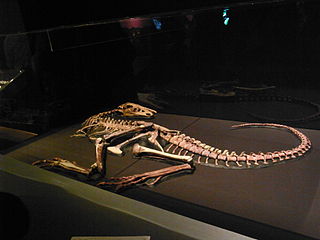
Raptorex is a potentially dubious genus of tyrannosaurid dinosaur. Its fossil remains consist of a single juvenile specimen probably uncovered in Mongolia, or possibly northeastern China. The type species is R. kriegsteini, described in 2009 by Sereno and colleagues. The genus name is derived from Latin raptor, "robber", and rex, "king". The specific name honours Roman Kriegstein, a survivor of the Holocaust, whose son Henry Kriegstein donated the specimen to the University of Chicago for scientific study.
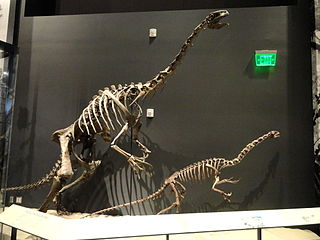
The timeline of therizinosaur research is a chronological listing of events in the history of paleontology focused on therizinosaurs. They were unusually long-necked, pot-bellied, and large-clawed herbivorous theropods most closely related to birds. The early history of therizinosaur research occurred in three phases. The first phase was the discovery of scanty and puzzling fossils in Asia by the Central Asiatic Expeditions of the 1920s and Soviet-backed research in the 1950s. This phase resulted in the discovery of the Therizinosaurus cheloniformis type specimen. Soviet paleontologist Evgeny Maleev interpreted these unusual remains as belonging to some kind of gigantic turtle.

Oksoko is a genus of oviraptorid dinosaur from the Late Cretaceous of Asia, that lived in what is now the Nemegt Formation in Mongolia. It includes the type species Oksoko avarsan.
Harenaichthys is an extinct genus of osteoglossiform fish that lived in Mongolia during the Late Cretaceous and was found in the Nemegt Formation. The type species is H. lui and is based solely on the holotype, which consists of partial skull parts, isolated and articulated centra, and an articulated caudal fin preserved together within a single sandstone block. The monospecific assemblages of Harenaichthys were affected by the high altitude of their habitat and the fossils show signs of pathologies caused by diseases while the animals were still alive.

Natovenator is a genus of halszkaraptorine dromaeosaurid dinosaur from the Late Cretaceous Barun Goyot Formation of Mongolia. The genus is known from a single species, N. polydontus. Natovenator is crucial to the understanding of halszkaraptorines due to it providing more support for the semi-aquatic lifestyle that has been proposed for this clade. This discovery is important as the semi-aquatic lifestyles of halszkaraptorines was contested in early 2022.

















